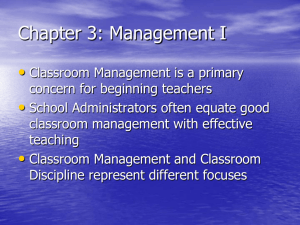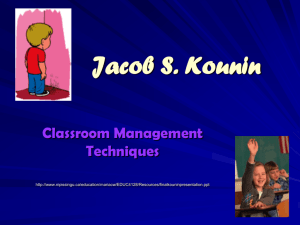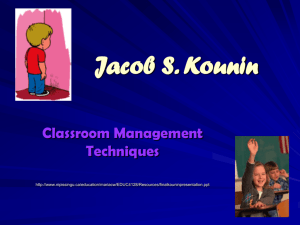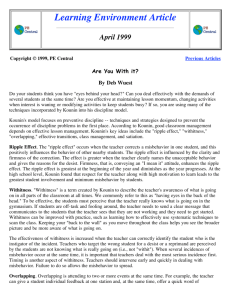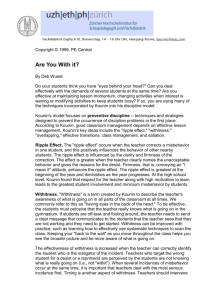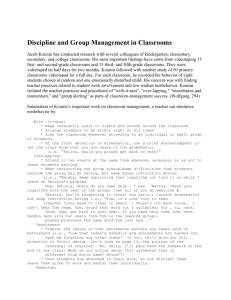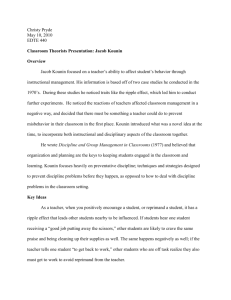Jacob S. Kounin
advertisement
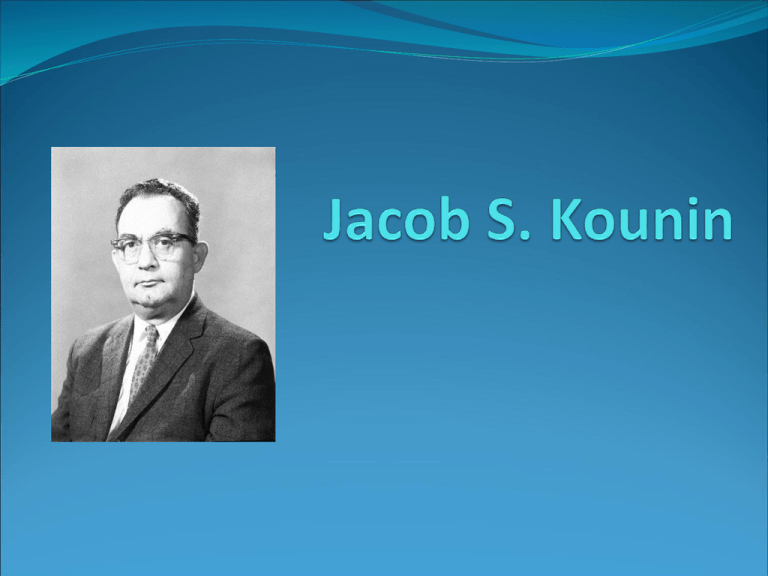
Biography Kounin began his career in 1946 as an educational psychologist at Wayne State University, Detroit, Michigan. He is best known for his studies on classroom management which took place during the 1970’s. Focused on preventive discipline techniques & strategies designed to prevent occurrence problems His findings were based on videos taken in 80 different elementary school classrooms as well experiments on college, high school and elementary school aged students over a five year period. His book, “Discipline and Group Management in Classrooms”, published in 1977, summarizes the behaviors of both effective and ineffective management. Key Vocabulary Ripple effect Momentum Withitness Smoothness Overlapping Withitness A teacher’s ability to know what is going on in all areas of the classroom at all times. This trait is communicated more effectively by teachers' behaviors than by their words. It is effective only if students are convinced that the teacher really knows what is going on. They pick up in the 1stsign of misbehavior, ignore minor misbehavior to stop a major infraction Smoothness Transitioning from one activity to another without disruptions. Lesson flow & time management Kounin and Gump (1974) demonstrated that lesson formats as totalities varied along dimensions of continuity, insulation, and intrusiveness Lessons are associated with the amount of given task High continuity in individual require: (a) that each child has the necessary props which he is able to manipulate appropriately (b) that his actions produce a visible effect which signals further action. Kounin S, Doyle, J. (1975). Momentum Refer to teachers’ starting lessons with dispatch, keeping lessons moving ahead, making transitions among activities efficiently, & bringing lessons to a satisfactory close. Overlapping The ability to attend to two issues at the same time. The Ripple Effect When teachers correct misbehaviors in one student, it often influences the behavior of nearby students. The Ripple Effect The control technique (3) The children's reactions (5) The impact of the setting The Ripple Effect in Discipline The control technique (3) Clarity – clarity of the directions teacher provides to students Ex: “Stop it!” , “Don’t do that!”, “ We don’t take the blocks away when someone's using them” Firmness- how much the teacher “means it” Proximity to the child (walking over, touching, guiding) Roughness – Teacher expressed hostility or exasperation gave child a warning look which was more angry than serious Touch had more pressure/ shouting Article by Jacob S. Kounin and Paul V. Gump …The Ripple Effect in Discipline The children's reactions (5) Sometimes boys & girls showed no reaction - they just continued what they were doing “Behavior disruption” - children reacted sharply to the correction of a classmate. o Students would lose interest in what they were doing & became worried, confused, and restless. “Conformance” - children responded with a special effort to be good. o Trying to show no misbehavior stopped on their own, sat up taller, paid closer attention to the lesson “Non-conformance”- correction had no prevention whatsoever o If a student was corrected for their misbehavior, another child would misbehave Children in the audience vacillated between conformance & non- conformance. o Both conformed & misbehaved. Article by Jacob S. Kounin and Paul V. Gump …The Ripple Effect in Discipline The impact of the setting Children who were misbehaving-or related to misbehavior-were much more responsive as they watched the teachers' efforts to control Children who were free of misbehavior were quite likely to show no reaction. Children who were misbehaving showed more conformance, more nonconformance, & markedly more vacillation between conformance and nonconformance. Effects for clarity were obtained regardless of whether or not the watching child was associated with misbehavior Firmness affected only groups that had some connection with misbehavior. In these groups, high firmness increased conformance & decreased non-conformance Article by Jacob S. Kounin and Paul V. Gump Application of Theory Use the ripple effect to your advantage by using phrases like, "I see many people have already completed half their work." to get students who are not working back on task. Let students know that you are aware of their behavior by saying things like, "I see you have barely started. This work must be done today!“ Call on students in discussions as a way to involve them in the lesson and keep them engaged. Point out progress when it occurs. For example, "Good! Now you are on the track! Keep up the good work.“ Provide variety. Continually challenge students to accomplish more. Hold students accountable with group focus techniques. Do not disregard students because they have been nonproductive in the past. Vocabulary Withitness Smoothness Overlapping Ripple effect Momentum References Andrius, J. (n.d.). TeacherMatters - Classroom Management and Discipline - The Kounin Model of Discipline | TeacherMatters - Classroom Management a. TeacherMatters. Retrieved May 13, 2011, from http://www.teachermatters.com/classroomdiscipline/models-of-discipline/the-kounin-model.html Kounin S., Gump V. (1958). The Ripple Effect in Discipline. The Elementary School Journal, Vol. 59(No. 3 ), pp. 158-162. Retrieved May 12, 2011, from http://www.jstor.org/stable/999319 . Ryan, K., & Cooper, J. M. (n.d.). Those Who Can, Teach - Google Books. Google Books. Retrieved May 12, 2011, from http://books.google.com/books?id=rqmdR6Xrgq8C&pg=PA189&lpg=PA189&dq=james+k ounin&source=bl&ots=9YUnHUZ6rJ&sig=in0vVOBGQty2n3OoSkh_GuJmerU&hl=en&ei =DnfMTeWAIJTSiALQtJCgBQ&sa=X&oi=book_result&ct=result&resnum=5&ved=0CDIQ 6AEwBDgK#v=onepage&q=james%20kounin&f Kounin S, Doyle, J. (1975). Degree of Continuity of a Lesson's Signal System and the Task Involvement of Children. Journal of Educational Psychology, Vol. 67(No. 2,), 159-164. Retrieved May 13, 2011, from the PsycARTICLES database.

